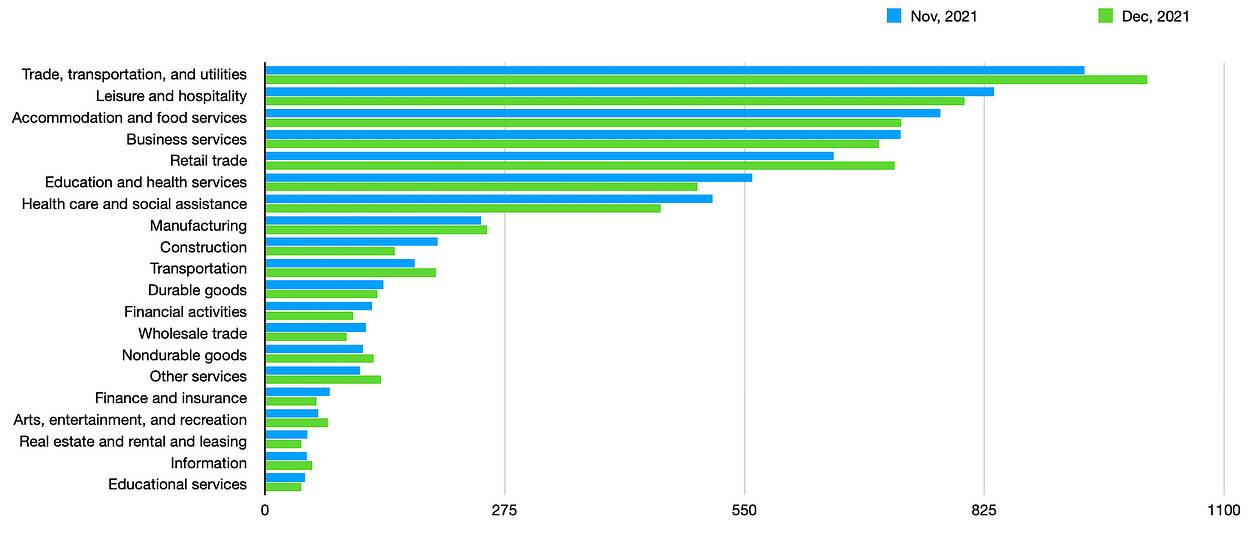The COVID-19 pandemic and an exhausting labor workforce — burnout — have led to what is now known as the Great Resignation. In the last two years, millions of workers were negatively impacted, and or laid off. Millions more quit and left the job market either temporarily or permanently.
The Great Resignation has caused millions of workers to rethink life and their career choices and for the majority to find a flexible work—life balance.
According to the U.S. Bureau of Labor Statistics, quits are generally
voluntary separations initiated by the employee. Therefore, the quits rate can serve as a measure of workers’ willingness or ability to leave jobs. In 2021, the number of quits edged down in December to 4.3 million.

“It’s not just about getting another job, or leaving the workforce, it’s about taking control of your work and personal life, and making a big decision — resigning — to accomplish that,” — Anthony Klotz, an organizational psychologist and professor at Texas A&M University, on CNBC Make It
A resignation and career change often come with a lot of anxiety and uncertainty. Seeking to redefine or rediscover yourself through a career change often feels like a daunting task for many.
The way to succeed isn’t necessarily to get out of your comfort zone — but to find a strategy that works for you. To take the leap — find a rewarding and fulfilling job. Once you’ve taken time to destress and recover, it's time to get back on your feet and find that dream job — if not going the self-employment route.
The Job Application Cycle
The job application cycle often entails submitting Application after application — adding the same information that’s on your resume onto a company’s job application (website). And then adding a cover letter (if needed). If the Cover Letter isn’t required, you sigh with relief. Hit submit.
Repeat…
TYPING away at every single job title that comes to mind that you think is cool. It gets overwhelming. Every single one of them seems daunting. There are “so many openings” and “few candidates” — you hear this all over the news media often.
So, if there are so many open jobs, why are there “few candidates”? And why does your search seem monotonous?
Is there a strategy to land the dream job?
I’ve found that the following unique strategy does the trick, every single time.
Search within your network
The first thing you need to do is to set up a good LinkedIn profile that established “who you are” — your brand.
Don’t treat LinkedIn like just another “social media” profile. It’s your professional profile. Search LinkedIn for popular and well-designed profiles to get started.
Establish strong trusted contacts within LinkedIn.
This effort typically takes time and research. Do that first. Don’t rush into adding many contacts — unless you are an influencer or marketer (digital or other).
Your social network is your net worth.
Chances are that if you are reading this, you have a professional or social network of like-minded individuals. Mentors and colleagues you’ve worked with before. It’s often said that from within this circle is where you find the hidden job market — jobs that don’t get posted to LinkedIn, Glassdoor, or Indeed, etc.
Determine how strong you would like your network to be. When done correctly, this could expand your job search network tremendously.
Whenever a new opening(s) comes up in a company, the posting(s) are normally distributed internally — in the company’s intranet. Internal candidates are advised to apply. If those postings go unfilled, then the posting is made available to the general public. Chances are that if you have a professional connection within that company, you could be notified once the posting is made available to the public. Alternatively, your connection could make a referral for you. This means that you would have the first opportunity to apply for the job before everyone else.
Therefore, establishing strong professional networks is key for your career and professional advancement.
Search for your dream role by Industry
Another strategy that’s often overlooked is searching for your dream role based on Industry. Find industries within your niche that are hiring. This could be Healthcare, Technology Financial Industries, etc. The connections you’ve established in your professional network — LinkedIn — will open doors to other professionals within their networks, industries, and job functions e.g. data engineering, software development, or marketing.
Many organizations are currently investing heavily in Cloud Computing and digital technologies.
With the growth of cloud computing and the generation of petabytes of data, there’s a great demand to hire technology and management professionals (and other job functions) to help organizations ride the wave of digital transformation and disruption.
Once you have built up your professional network, now is the time to get to work.
For the most part, your network will comprise individuals in the same Industry.
Leveraging this professional network is one of the most crucial steps in finding your dream job.
The assumption here is that these connections go beyond your current locality and organization. In addition, having connections in different departments (job functions — data engineering, marketing, etc.) within an organization boosts your chances of establishing a strong referral that spans different departments.
These two strategies should ideally get you started to find a job that fits you.

